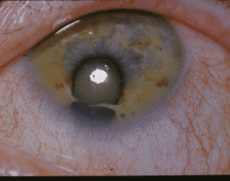- Coloboma
-
Coloboma Classification and external resources 
ICD-10 Q10.3, Q12.2, Q13.0, Q14.2, Q14.8 ICD-9 377.23, 743.4, 743.46, 743.52, 743.57 DiseasesDB 29894 MeSH D003103 A coloboma (from the Greek koloboma, meaning defect,[1] and also part of the rare Cat eye syndrome) is a hole in one of the structures of the eye, such as the iris, retina, choroid or optic disc. The hole is present from birth and can be caused when a gap called the choroid fissure between two structures in the eye, which is present early in development in the uterus, fails to close up completely before a child is born. The classical description in medical literature is of a key-hole shaped defect. A coloboma can occur in one or both eyes.
Contents
Presentation
The effects a coloboma has on the vision can be mild or more severe depending on the size and location of the gap. If, for example, only a small part of the iris is missing, vision may be normal, whereas if a large part of the retina or optic nerve is missing, vision may be poor and a large part of the visual field may be missing. This is more likely to cause problems with mobility if the lower visual field is absent. Other conditions can be associated with a coloboma. Sometimes the eye may be reduced in size, a condition called microphthalmia, or there may be glaucoma, nystagmus, scotoma or strabismus.
Related conditions
Some children with coloboma of the eye also have malformations in other parts of the body. There is a rare condition called CHARGE syndrome, in which coloboma is associated with cleft lip and/or palate, ear abnormalities and hearing impairment, choanal atresia, delays in growth and development, central nervous system anomalies, lesser vision in extreme or little light and congenital heart defects. It can also be associated with Klinefelter Syndrome and Marfan syndrome.[citation needed]
Causes
Colobomas can be associated with a mutation in the PAX2 gene.[2]
Incidence
The incidence of coloboma is estimated at around 0.5 to 0.7 per 10,000 births, making it a relatively rare condition.[3]
Perhaps the most famous people with coloboma are John Ritter, Henry Cavill, Danielle Minton, New York Times columnist Andrew Ross Sorkin, alternative rock singer songwriter Lachi and Madeleine McCann. McCann, a British girl, disappeared from the vacation resort rented by her parents in May 2007 just before her fourth birthday. Posters and online campaigns promoting the search for Madeleine use the word "Look" with the first "O" in the word being drawn in the shape of a coloboma radius extending from the pupil at the 7 o'clock position.
Treatment
There is no treatment for the visual impairment caused by coloboma at present. Specialized contact lenses can be used later in life.[4]
References
- ^ coloboma, Mosby's Medical, Nursing and Allied Health Dictionary, Fourth Edition, Mosby Year-Book, 1994, p. 361
- ^ Cunliffe HE, McNoe LA, Ward TA, Devriendt K, Brunner HG, Eccles MR (October 1998). "The prevalence of PAX2 mutations in patients with isolated colobomas or colobomas associated with urogenital anomalies". J. Med. Genet. 35 (10): 806–12. doi:10.1136/jmg.35.10.806. PMC 1051454. PMID 9783702. http://www.pubmedcentral.nih.gov/articlerender.fcgi?tool=pmcentrez&artid=1051454.
- ^ Hornby, SJ et al. "Visual acuity in children with coloboma". Ophthalmology 107(3):511-20
- ^ RNIB database - Supporting blind and partially sighted people - Coloboma; http://www.rnib.org.uk/xpedio/groups/public/documents/PublicWebsite/public_rnib003643.hcsp#P92_9303
External links
Congenital malformations and deformations of eyes (Q10–Q15, 743) Adnexa Globe Entire eyeAnterior segmentOtherM: EYE
anat(g/a/p)/phys/devp/prot
noco/cong/tumr, epon
proc, drug(S1A/1E/1F/1L)
Categories:- Diseases of the eye and adnexa
- Congenital disorders of eyes
Wikimedia Foundation. 2010.
